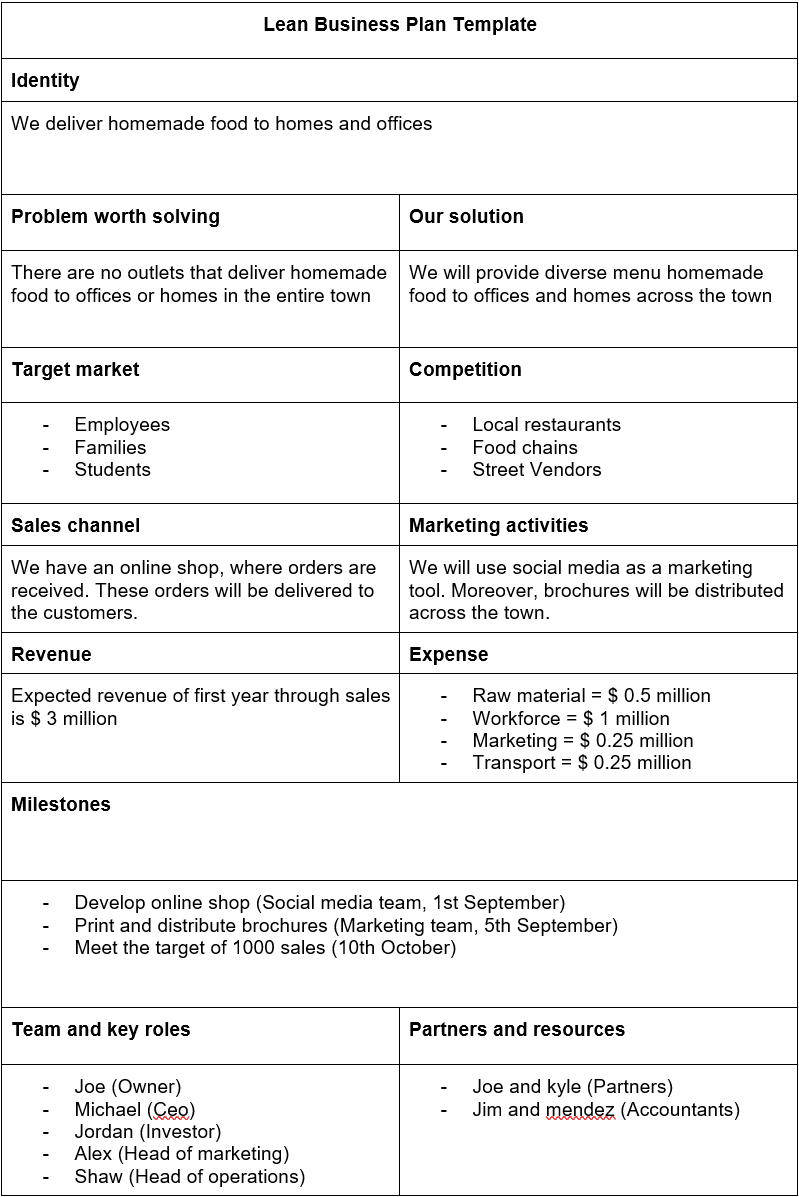People often say that to succeed, businesses must have a business plan. However, this statement has slightly changed over the years.
It is said that to succeed, businesses must have a lean business plan. So you guys must be thinking, what the difference between these two is?
Today we will discuss how the lean business model differs from the traditional business model and what the lean business model is in general.
To operate a business, it is essential to construct a business model first. A business model provides a plan to run the business by identifying the customer base, sources of revenue, sources of financing, and the product that is to be offered.
Businesses make business plans to get direction. A business plan helps in making the business strategy and prioritizing tasks. Therefore, businesses must develop a business plan to operate in an organized manner.
The traditional business plans were used to cover all the details about a business, due to which they used to be 45-50 pages long. However, as time passed, businesses needed to make shorter and more precise business plans.
There were specific reasons why the need for shorter business plans was felt. One of the reasons was the argument that people don't read lengthy business plans, due to which their purpose is not fulfilled.
Moreover, it was considered that short and precise business plans were more efficient and productive since businesses require less time to implement them, and it is easy to understand.
To overcome the shortcomings of a traditional business plan, the lean business model was introduced. The term "lean startup" was coined by Eric Ries, an entrepreneur, a decade ago. However, Henry Ford was among the first entrepreneurs who practically used lean business plans in the 20th century.
The success of implementing a lean business plan can be estimated from the fact that in recent times, many successful businesses such as Zappos, Buffer, and Dropbox adopted lean business plans to provide direction to their businesses.
A lean business plan is a shorter and more precise version of the traditional business plan, which consists of small steps prescribed to the management to make a business successful.
The lean business plan includes the business's strategy, the tactics to implement the strategy, the schedule for monthly reviews, and the forecast and budgeting of the business.
Let's proceed further to get more insight into the lean business plan and see its significance in the modern business era.

How to Write a Lean Business Plan
A lean business plan is similar to the traditional business plan as they both provide direction to the business. However, a lean business plan consists of only one page since only vital points are written in the form of bullets.
The usage of lean business plans is increasing in the business sector as it is considered more efficient and effective. In this section, we will discuss how to write a lean business plan.
1. Business Strategy
Similar to the traditional business plan, one of the main components of the lean business plan is the provision of a business strategy. Although a business strategy summarises your plans, it also identifies your customers and competitors.
The business strategy part of the lean business plan identifies the problem which your product will solve. It then tells how your product will solve that problem. For example, suppose there's a lack of homemade food available in your town, and you plan to work on that. In that case, your business strategy will identify the problem and provide a solution for it.
Business strategy also describes the details of the product's targeted audience and potential business competitors. For example, it tells what gender and age group your product will target. Moreover, it also makes the business aware of the competitors in the market.
2. Business Tactics
The lean business plan also identifies the tactics used to execute the business strategy. Another significant component of the lean business plan is developing business tactics. The business tactics provide a pathway to implement the business strategy.
This section of the lean business plan narrows down how the business strategy should be implemented. For example, it highlights what the marketing, sales, and HR strategy should be to make the business grow effectively.
3. Schedule
Every lean business plan must contain the schedule part. The schedule section ensures that all the employees' business strategies, tactics, and work are revisited. Since a lean business plan is all about efficiency, designing a good schedule leads to an effective business plan.
With the help of a schedule, the goals and milestones set by the business can be reviewed to see where the business is standing in reality. Moreover, indicators and statistics help in analyzing the performance of the business.
However, the type of schedule varies for startups and established businesses. The schedule of a startup will analyze the consumer's demands and market trends. To do that, the startup will send out questionnaires and surveys to get all this information.
On the other hand, for a well-established business, the focus of the schedule is to analyze the goals to be achieved. Moreover, the workers' performances are analyzed after a set interval time. All this is done to analyze whether the business is moving in the right direction.
4. Forecast and Budgeting
Finally, the lean business plan should contain forecasts and budgeting statistics. No matter how good a business plan is, as long as you have not sorted out the cash flows and calculated the expected revenues, your business plan can't succeed.
Forecasting and budgeting help to convert the business plan into a reality by estimating sales and expenses. The business model is restructured if the expected revenues are insufficient to meet the expenses or generate good profit.
In the next section, we will look at an example of the lean business plan template. So let's move ahead and see what the template looks like.
Lean Business Plan Template

The above template shows how the lean business plan can precisely present a business plan on one page. Although it contains the entire business plan, it is very precise and easy to understand.
Difference Between a Traditional Business Plan and a Lean Business Plan
Both the traditional business plan and the lean business plan provide a business plan to the management. Working on this plan, a business can succeed since a set pathway and direction are provided in the plan.
For decades the traditional business plan has been used to set the direction of the business. However, in the past few years, the lean business plan has been adopted by businesses all over the globe. This section will discuss the difference between a traditional and a lean business plan.
1. Size of the Document
Although there are many differences between the traditional and lean business plans. However, One of the visible differences between the two is the size. The traditional business plan consists of nearly 45-50 pages or more, whereas the lean business plan fits on one page.
2. Detail Presented
The traditional and lean business plans cover a business plan's main aspects. However, they differ when it comes to the details which are present in the business plan. The traditional business plan is known for the details it covers. It explains every component of the business plan in detail. This provides clarity to the reader.
Whereas the lean business plan is famous for having pointers that give a general idea to the reader without explaining anything in detail. This saves time for the reader and makes it easy to understand.
3. Time Required to Construct
The traditional business plan and lean business plan also vary when it comes to the time needed to construct the business plan. The traditional business plan requires more time to construct since much research is needed before constructing it.
On the other hand, the lean business plan requires less time since no detailed analysis is required to construct it.

Advantages of Lean Business Plan
Until now, we discussed how to construct a lean business plan and the difference between a traditional and a lean business plan. However, in this section, we will look at what are the reasons that businesses have decided to adopt the lean business plan instead of the traditional one.
1. Quick Access to Market
As we discussed earlier, the lean business plan is famous for being less time-consuming as it doesn't involve many details. Moreover, it requires less time to make a lean business plan than the traditional one.
All these factors help the business to introduce its product in the market early. Therefore, the lean business plan is extremely efficient and beneficial in highly competitive or time-sensitive markets.
2. Less Time and Money Spent
Since the lean business plan doesn't contain much detail, no detailed analysis is done. Hence, less time and money is spent on constructing the lean business plan. For any business, especially for startups, this factor holds great significance.
Due to this trait of the lean business plan, even if the business crashes, not much time and money is wasted in constructing the business plan.
3. Attracts Investors
Every business is looking to catch investments to ensure the smooth running of the business. As a result, businesses that have lean business plans often attract investors compared to businesses with traditional business plans.
The reason why a lean business plan attracts more investors is that investors are busy people who have more money and less time. Therefore, any investor would read a one-page lean business plan but not be interested in reading a 50-page business plan.

Lean Business Plan: Final Word
At the end of this article, let's summarise whatever we have discussed.
In this article, we gave you guys an insight into what a lean business plan is. We shed light on a traditional business plan and how a lean business plan differs from the traditional business plan.
Moreover, the components of the lean business plan were also highlighted. The lean business plan consists of business strategy, business tactics, schedule, forecasting, and budgeting.
Furthermore, to make you guys better understand what a lean business plan is, a template of the lean business plan was made available to the readers.
The differences between traditional and lean business plans are highlighted in this article. It was established that the lean business plan is more precise, less time-consuming, and less detailed.
In the end, some advantages of the lean business plan were discussed. For example, a lean business plan attracts more investors. Moreover, constructing a lean business plan is less costly and time-consuming. We hope that you'll enjoy this article and gain awareness about the lean business plan.








